She is just gorgeous! Even if we do have not this image in a complete form, still it is a unique Masterwork.
Shroud of the “Lady of the Vatican”
This linen canvas, known as the “Lady of the Vatican”, belongs to a particular type of female burial shroud. There are only six known specimens dispersed in various museums.
The portrait of the deceased is not limited solely to the face but instead depicts the full life-size figure of the woman. She is reclining, as may be seen by the position of her feet, which are elongated and rest on a cushion. She wears jewellery, executed in relief using plaster and gilded.
The figurative panel is divided, in the upper part, by a series of concentric frames and friezes and, in the lower part, by a frieze divided into rectangular areas with figurative illustrations, of which two are conserved: in the first, there is a scene of philosophical instruction with a teacher and young pupil, probably the deceased herself; in the second, of a doubtful interpretation, there is what appears to be a fight between a young man and a lion.
The shroud was discovered in 1900 by Albert Gayet in the site of Antinopolis and donated to Pope Leo XIII in 1902 by Émile Guimet, along with the corresponding mummy. The archaeological context of origin and an iconographical study of the portrait would date it from the third century A.D. The robe and jewels are typical of the Roman context, and the hairstyle, in particular, is inspired by the fashion of women of the Severian imperial house.
Here is a brilliant description of the find and its story by Marie Grillot. 🙏💖🙏
Une belle romaine d’Antinoé devenue “Dame du Vatican” via https://egyptophile.blogspot.com/

Provenance: Antinoé – Excavations by Emile Guimet directed by Albert Gayet
Vatican Museum – Inv. 17953 – Gift of Émile Guimet – 1902
Toile funéraire de femme, appelée aussi “Dame du Vatican”.Antinoé – IIIe siècle après J.C.
“It is the first mummy with a painted portrait that M. Gayet brought back from Antinoe. I thought it was Christian, and I gave it to the Vatican Museums with all the fabrics with Christian symbols around it. “indicates Emile Guimet in” The portraits of Antinoé at the Guimet Museum “.
This is how this fragmentary shroud, 1.73 m high, 13 to 52 cm wide, representing a lady of good Roman society from the beginning of our era, took, in 1902, the route of the Holy See, under the pontificate of Leo XIII. She was then, in a beautiful way, “assimilated” to her new “home” since she was very quickly called the “Lady of the Vatican”.

The canvas of the “Lady of the Vatican” – Painted linen – 3rd century A.D. J.-C.
Provenance: Antinoé – Excavations by Emile Guimet directed by Albert Gayet
Vatican Museum – Inv. 17953 – Gift of Émile Guimet – 1902 – Photo of the Museum
“She is part of a typology of female funeral canvases of which only six examples are known in museums worldwide. The portrait of the deceased is not limited to the face, but the woman is represented life-size, full-length. . She is stretched out, as can be seen from the position of the feet stretched out and resting on a cushion. She wears jewellery, made in relief, in plaster and gilded, “specifies the Museum …
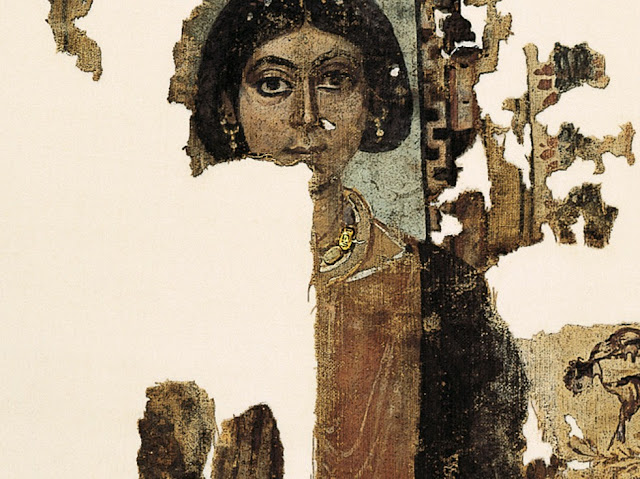
Provenance: Antinoé – Excavations by Emile Guimet directed by Albert Gayet
Vatican Museum – Inv. 17953 – Gift of Émile Guimet – 1902
Her face, of beautiful symmetry, is lit by large eyes edged with kohol. The iris, round and black, stands out against the white of the eye, which seems wet with tears. The eyebrows are nicely arched, while light circles mark the lower eyelid. The nose is small. The palate is small, with a marked cupid arch and slightly raised corners.
Her brown hair, styled in a short “square”, is separated by a central part and adorned with a pearl tiara. The hairstyle slightly returned to the back, revealing beautiful pendant earrings adorned with pearls.

The canvas of the “Lady of the Vatican” – Painted linen – 3rd century A.D. J.-C.
Provenance: Antinoé – Excavations by Emile Guimet directed by Albert Gayet
Vatican Museum – Inv. 17953 – Gift of Émile Guimet – 1902
She is wearing a purple-orange tunic embellished with a thin white border at the neckline and purple clavis that: “fall on her forearms and reach just above the knees; the one on the right is stopped on the dress by a pin. The nails go down from the arms and delimit the central part, occupied by a shawl. At the height of the belt, the abdomen and the legs up to the knees are, in fact, covered with a rectangular fabric or fringed and with two large purple medallions applied to the centre, “says Lorenzo Nigro in his excellent study” The portrait of the ‘Lady of the Vatican’ on the linen cloth by Antinoe: a new interpretive analysis after the restoration. “
Necklaces of gold and precious stones adorn her neck; her wrists also are adorned with bracelets embossed in gold leaf. We admire the elegance of the gesture she sketches with her hand with long tapered fingers, which perfectly highlights the ring she wears on her left ring finger.
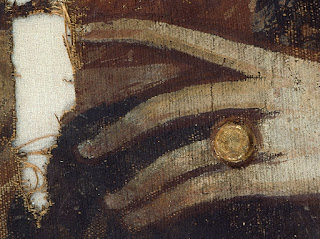
Provenance: Antinoé – Excavations by Emile Guimet directed by Albert Gayet
Vatican Museum – Inv. 17953 – Gift of Émile Guimet – 1902
“The presence of the ring is particularly significant because this attribute indicates with good reliability the belonging of the woman to an aristocratic family. In fact, it is not a simple personal ornament. Still, an indicator of the social rank of The set of precious ornaments described makes the ‘Lady of the Vatican’ one of the most richly decorated female figures in the available presentations of the same series of works, in particular, thanks the jewellery is worn around the neck “(Lorenzo Nigro).

The canvas of the “Lady of the Vatican” – Painted linen – 3rd century AD. J.-C.
Provenance: Antinoé – Excavations by Emile Guimet directed by Albert Gayet
Vatican Museum – Inv. 17953 – Gift of Émile Guimet – 1902
published in “Les portraits d’Antinoé au Musée Guimet”, Emile Guimet, Librairie Hachette et Cie, Paris
The rest of the canvas, unfortunately incomplete, presented one: “series of frames and concentric friezes and, in the lower part, a frieze divided into small rectangular panels, of which only two are preserved: in the first one we have to distinguish a scene of philosophical instruction with a master and a young pupil, probably the deceased herself; in the second, less readable, one indicates a fight between a young man and a lion “.
The hairstyle, clothes and adornments have made it possible to date this shroud from the 3rd century, particularly from the Severan dynasty, founded by Septimius Severus in 193 AD. J.-C …
The city of Antinoe where it was discovered is located in Middle Egypt, on the eastern bank of the Nile, 300 km south of Cairo. The city already existed in the New Kingdom, but Hadrian renamed it in the 1st century from the name of his handsome lover Antinous. Its ruins today extend into a village called Sheikh ‘Abade.
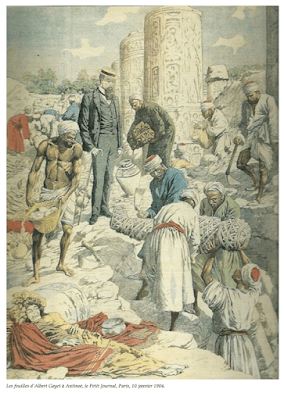
Illustration representing Albert Gayet’s excavations in Antinoopolis (published in the Petit Journal – 1904-686)
From 1896, in agreement with the Direction of the Antiquities Service, Emile Guimet will become, for many years, the patron of the excavations directed by Albert Gayet. This Dijon Egyptologist arrived in Egypt in 1881 with the Permanent French Archaeological Mission in Cairo created by Gaston Maspero. This last will push him towards “a direction still little known: the archaeology of Egypt of late antiquity”. This is how he will become a specialist …
Antinoé will reveal the secrets of his necropolises throughout the missions: painted portraits and fabrics and clothes are certainly their most beautiful treasures. They make it possible to “revive” a whole cosmopolitan society rich in various influences; this “lady” is a perfect example …
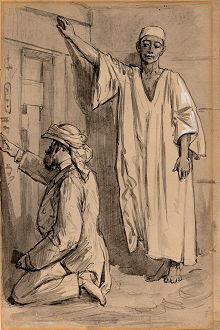
Anonymous, Monsieur Guimet reading an Egyptian inscription
Ink on paper – Lyon, Musée des Beaux-Arts
How not evoke this excellent analysis made by Emile Guimet? “Was the ‘Vatican Lady’ ‘idolatrous’ or was she ‘Christian’? We won’t know. She was a bit isiac (of or about the goddess Isis or her worship), because of the Egyptian temple door that surrounds her face; she was a bit Buddhist, by the windings which adorn the medallions of her dress; she was a little Syriac, by the miniature painting which adorns her shroud and represents two figures seated to the right and the left of the tree of life; she was a little Christian, by the gesture of her right hand which the lady with the golden cross will imitate, by her spiritual aspirations, by the symbols spread on the fabrics found around her. Ensured all paradises “.
The “Lady of the Vatican” was registered at the Museum, which gave her name under the inventory number 17953.
Sources:
http://www.museivaticani.va/content/museivaticani/fr/collezioni/musei/museo-gregoriano-egizio/sala-ii–costumi-funerari-dellantico-egitto/telo-della-_dama-del-vaticano-. html
Il ritratto Della ‘Dame du Vatican’ sul telo linteo da Antinoe: Una Nuova Analisi interpretative Dopo il restauro, Lorenzo Nigro
(excerpts translated by Marc Chartier)
https://www.academia.edu/1095887/Il_ritratto_della_Dame_du_Vatican_sul_telo_linteo_da_Antinoe_una_nuova_analisi_interpretativa_dopo_il_restauro?fbclid=IwAR3PwJbcnfUZJVJXHJX4zbfuDBiZVJVJXHJX4zbfBiZBiZJVJXHJX4zbcbiqiZjVJXHJX4zbfDbiZVJVJXHJX4zbfjbiZJVJXHJX5
The portraits of Antinoé at the Guimet Museum, Emile Guimet, Librairie Hachette et Cie, Paris
http://dlib.nyu.edu/awdl/sites/dl-pa.home.nyu.edu.awdl/files/lesportraitsdant00guim/lesportraitsdant00guim.pdf
“Exploration of the ruins of Antinoe and the discovery of a temple of Ramses II enclosed within the walls of Hadrian’s town”, Albert Gayet, editions E. Leroux (Paris), 1896
http://gallica.bnf.fr/ark:/12148/bpt6k57769062
One day I bought a mummy – Emile Guimet and Ancient Egypt – Musée des Beaux-Arts de Lyon – Exhibition from March 30 to July 2, 2012
https://www.mba-lyon.fr/sites/mba/files/medias/images/2019-12/dpresse_expo_eggypt_antique.pdf
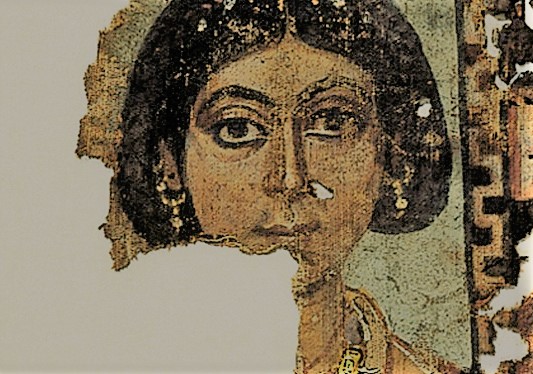

So interesting!!!!!!
Thanks for sharing
LikeLiked by 1 person
Thank YOU, my dear Luisa. 🙏🥰💖
LikeLiked by 1 person
A gorgeous painting. Good find!
LikeLiked by 1 person
Yes, surely it is, Thank you, my friend,
LikeLike
What a splendid portrait. Thanks for sharing!
LikeLiked by 1 person
Fascinating, isn’t it? Thank you, my dear teacher. 🙏🥰😘
LikeLike
Fascinating, as always dear Aladin. Thank you for sharing another of Marie’s brilliant posts. Did I ever tell you that my mother allegedly descended from Egyptian pirates? Her ancestors were known as “The Sea People” well according to Ancestry DNA. Perhaps this is why I choose to live by the sea and why I’m quietly fascinated by all things Egyptian too. Love and light, Deborah.
LikeLiked by 2 people
That tells everything 😉 I think that our roots are somehow originated somewhere from the past ❤️ thank you as always 🙏🌹
LikeLiked by 1 person
An excellent post! I have never heard of the Lady of the Vatican.
LikeLiked by 1 person
That’s also a surprise for me 😉 thank you so much, dear Rebecca, for your visit 🙏❤️
LikeLiked by 1 person
Very beautiful!!!
LikeLiked by 1 person
Indeed! Thank you, dearest Elizabeth for dropping by 🤗🙏🥰
LikeLike
So many mysteries and so much beauty! Thank you!
LikeLiked by 2 people
True, and we learn every day something new 🤗thank you 😊 🙏
LikeLiked by 1 person
Art, history, and mystery! What could be better? Thanks for sharing. 🙂
LikeLiked by 1 person
Indeed! Thank you for your kind words. You are much appreciated. 🙏💖
LikeLiked by 1 person